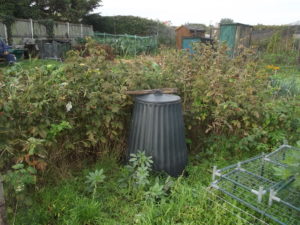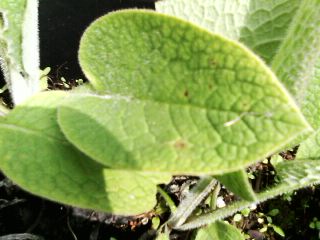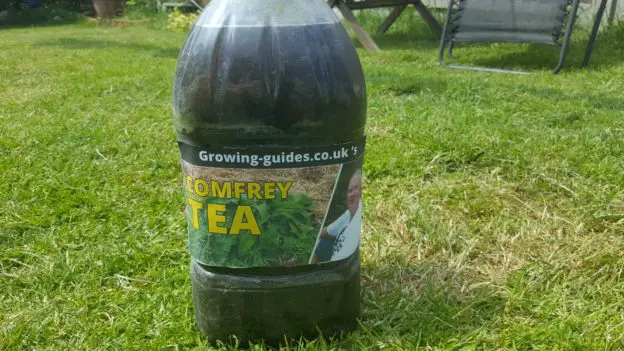What Is Comfrey?
Comfrey is a herb that back in the middle ages was used by healers for all manner of conditions including acne, varicose veins and many others but its alternative name of “knit bone” gives a clue as to its main use back in the day, to speed up the healing of broken bones. Well I can’t tell you if any of that is true, all I can tell you is that as a plant food comfrey tea is second to none. Comfrey has a tap root (like a dandelion root) which penetrates deep into the sub soil, down to about ten foot deep, absorbing all the deep nutrients that other plants can’t reach. This is what makes it a great tonic/feed.
What Does Comfrey Tea Do?
Comfrey tea is a excellent fertiliser and all round plant tonic/conditioner. Comfrey tea will encourage fruit to set and nourish your plants general health. Anything that flowers and then fruits will benefit from a comfrey tea feed once per week, fed after the plant has flowered.
How To Make Comfrey Tea

A comfrey plant – ideal for making plant food.
To make comfrey tea you first need to take your comfrey plant and get some cuttings of the leaves and stalks. Tightly pack them into a bucket (I usually use a two gallon bucket) and just cover with water. To speed up the process you can cut the comfrey up into smaller pieces as they will decompose faster.
Place a carrier bag over the top of the bucket to cover it. After around two weeks you find you have created a bucket of foul smelling black slime that is almost ready to nourish your plants. The last step is to strain the tea, to remove any of the comfrey plant that has not decomposed. To do this you can use a sieve, old pair of tights – literally anything that will allow water to pass through but nothing solid. Store the liquid you have just extracted in a bottle and secure the lid
You now have your comfrey tea plant food to aid anything that roots, shoots or fruits.
How To Prepare Comfrey Tea For Use
Comfrey tea used neat could potentially kill your plants as it is too strong. So we need to use it at a 9 to 1 ratio with water.
So to create a gallon of usable comfrey tea, place around a 1/10th of a gallon (roughly 450ml) of comfrey tea concentrate into your watering can and then dilute with 9/10th of a gallon (roughly 4l) of water. Stir this mixture for a few seconds with a stick and then it is ready for use.
If you want to make this really easy, you could use a gallon watering can, add your 1/10th of comfrey tea concentrate and then just fill up the remaining space with water.
This being said it doesn’t have to be 100% accurate, just ensure you have watered it down to around 10%.
How To Use Comfrey Tea?
Comfrey tea is great for your plants but only in moderation. Overfeeding the plant with comfrey tea will be to it’s detriment and could potentially kill it off so make sure you only feed them once per week maximum.
I don’t usually give my plants too much comfrey tea as it is very powerful stuff, only a quick splash every week will suffice. Also be thoughtful of the size of the plant/container. Give small plants less then you would large plants.
To encourage the type of growth you want, only use comfrey tea on the plant once it starts producing flower buds. It’s important that the plant is watered earlier in the day before giving it comfrey tea to avoid overfeeding your plant.
What Else Is Comfrey Good For

Comfrey has many uses, including being a great compost activator.
Comfrey is one of the most useful plants in the garden and it’s uses go well beyond (but not surpassing) just making comfrey tea. Comfrey is a great use to any compost heap/bin as it is a great activator. You don’t need to do anything to the comfrey, just add in anything of the plant you have left over (including the remains you get when sieving out the tea).
Comfrey is also a great mulch for plants as it is so full of nutrients. The only thing to note here is that you cannot include the flower heads of the comfrey plant as it will start to grow. This is because it is very prolific.
I’ve also had great results lining my potato trench with comfrey leaves and placing the tubers straight on top of the leaves and then burying in the usual way. This stops the potatoes from developing scab and also acts as a great feed and general tonic for the growing plants.
How To Grow Comfrey

A young comfrey plant, getting ready to help my garden grow.
As I mentioned earlier comfrey plants are very prolific so the hard part isn’t actually growing it, its getting rid of it when you no longer want it.
You can grow comfrey by seed or by root and it really doesn’t take much effort. If you want to grow it by seed just follow the usual steps to growing any seed. Or for root, simply place the root in the ground, water well and leave. Within days you will start to see new leaves growing and in a few weeks you will be able to harvest.
You don’t need to worry too much about over harvesting your comfrey plant as it is really resilient. The root goes down so deep (around 10 foot some times) and is so strong (it can break up rocks, hence why it contains so many minerals) that I have even completely harvested the plant and it has grown back completely within weeks just from the roots.
Why I Love Comfrey Plant Food
Comfrey tea is by far my favourite plant food as it is 100% natural and produces much better results then anything else I have tried over the years. That means it doesn’t cost you a penny and you don’t have to worry about what potential issues it could cause (like you do with non-natural plant foods).
A quick word of warning, I have seen some discussion that comfrey is poisonous if taken internally so don’t drink it (not that you could probably get past the smell) or eat the leaves, unless you are a plant.


I have some comfrey liquid left over from last year, so what dilution rate do you recommend?
Hi Rob,
Thanks for taking the time to read my blog. I would use about half as much again if it’s over wintered
All the best
Steve
Does comfrey tea liquid strengthen or weaken after winter storage?
Hi Rob,
Comfrey tea stores well, I usually add more to my watering can if it’s over a year old.
I hope this helps
all the best
Steve